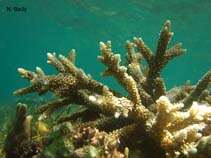Acropora formosa (Dana, 1846)
Warning: DOMDocument::load(): SSL operation failed with code 1. OpenSSL Error messages: error:140770FC:SSL routines:SSL23_GET_SERVER_HELLO:unknown protocol in C:\Apache24\htdocs\includes\SpeciesSummary.lib.php on line 1236
Warning: DOMDocument::load(): Failed to enable crypto in C:\Apache24\htdocs\includes\SpeciesSummary.lib.php on line 1236
Warning: DOMDocument::load(https://sealifebase.nrm.se/webservice/AquaMaps/getAMap.php?genus=Acropora&species=formosa): failed to open stream: operation failed in C:\Apache24\htdocs\includes\SpeciesSummary.lib.php on line 1236
Warning: DOMDocument::load(): I/O warning : failed to load external entity "https://sealifebase.nrm.se/webservice/AquaMaps/getAMap.php?genus=Acropora&species=formosa" in C:\Apache24\htdocs\includes\SpeciesSummary.lib.php on line 1236
Classification / Names Common names | Synonyms | CoL | ITIS | WoRMS
| Scleractinia | Acroporidae
Environment: milieu / climate zone / depth range / distribution range Écologie
Récifal; profondeur 0 - 25 m (Ref. 8294). Tropical; 30°N - 34°S, 27°E - 135°W (Ref. 846)
Distribution Pays | Zones FAO | Écosystèmes | Occurrences | Introductions
Indo-Pacific. Tropical and subtropical.
Length at first maturity / Taille / Poids / Âge
Maturity: Lm ? range ? - ? cm Max length : 49.0 cm COLD mâle / non sexé; (Ref. 269); common length : 49.0 cm mâle / non sexé; (Ref. 269)
Description synthétique Morphologie
This is the classic "staghorn coral", with aborescent growth form and branches usually less than 50 cm in length. Colonies are composed of smooth appearing, straight branches less than 2 cm thick; branching is irregular such that colonies from thickets which often dominate large areas of lagoon in shallow and intermediate depths (Ref. 269).
Depth based from occurrence record (Ref. 8294); to be replaced with a better reference. Dominates large areas of lagoon in shallow and intermediate depths (Ref. 269). Has high bleaching level and high estimated mortality in Palau (Ref. 66144).
Life cycle and mating behavior Maturité | Reproduction | Frai | Œufs | Fécondité | Larves
Hermaphroditic (Ref. 113712). Mature gametes are shed into the coelenteron and spawned through the mouth. Life cycle: The zygote develops into a planktonic planula larva. Metamorphosis begins with early morphogenesis of tentacles, septa and pharynx before larval settlement on the aboral end (Ref. 833).
Référence principale
Références | Coordinateur | Collaborateurs
Hodgson, G. 1998. (Ref. 269)
Statut dans la liste rouge de l'IUCN (Ref. 130435)
Quasi-menacé (NT) ; Date assessed: 03 January 2008
statut CITES (Ref. 108899)
Appendix II: International trade monitored
CMS (Ref. 116361)
Not Evaluated
Menace pour l'homme
Utilisations par l'homme
| FishSource |
Outils
Plus d'informations
Pays
Zones FAO
Écosystèmes
Occurrences
Introductions
Stocks
Écologie
Régime alimentaire
Éléments du régime alimentaire
Zones FAO
Écosystèmes
Occurrences
Introductions
Stocks
Écologie
Régime alimentaire
Éléments du régime alimentaire
Sources Internet
BHL | BOLD Systems | CISTI | DiscoverLife | FAO(Publication : search) | Fishipedia | GenBank (genome, nucleotide) | GloBI | Gomexsi | Google Books | Google Scholar | Google | PubMed | Hexacorallians of the World | Arbre de Vie | Wikipedia (Go, chercher) | Zoological Record
Estimates based on models
Preferred temperature
(Ref. 115969): 24.8 - 29.3, mean 28.4 (based on 3503 cells).
Catégorie de prix
(Ref. 80766):
Unknown.



